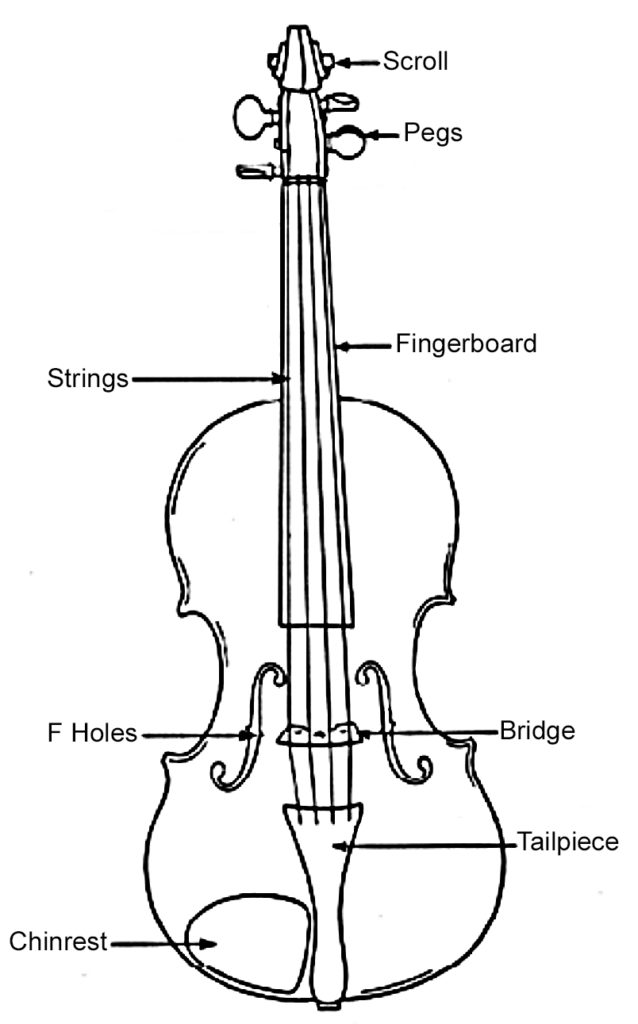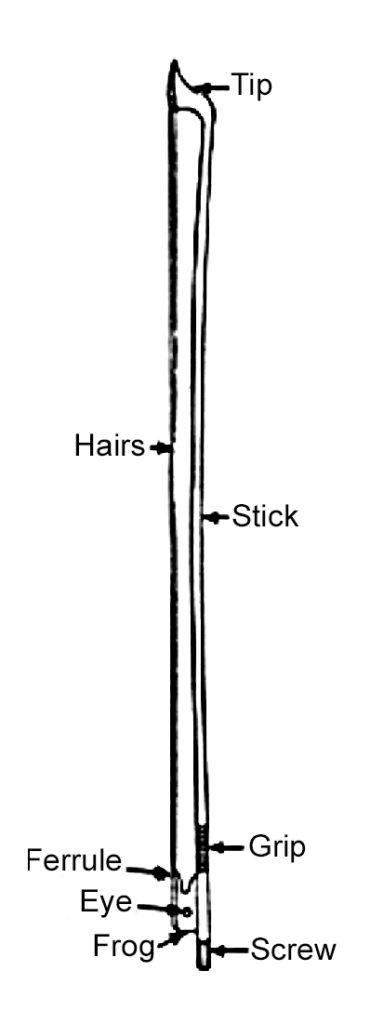Parts of the Violin and Bow
These pictures of the violin shows you the different parts and pieces associated with the violin instrument. Read below for more information on the different parts of the violin.

Scroll – The violin scroll is mostly for decoration and is in the shape of a paper scroll. This part of the violin is unique to string instruments and is also found on the viola, cello, and bass. The scroll is usually hand carved and ads a beautiful touch to the violin.
Pegs – There are four pegs that hold the strings. The pegs and peg holes are tapered, so when tuning with the pegs it is necessary to push slightly inward toward the pegbox. When Holding the violin upright with the scroll to the ceiling and the strings facing you, turn the peg very slightly away from you (or up) to raise the pitch and the opposite way to lower the pitch.
Strings – There are 4 strings on the Violin. From highest pitch to lowest pitch (also thinnest to thickest string) the names of the violin strings are: E A D G
A fun way to remember the names of the violin strings is to sing: Each, Each Each, Each and Every, Ant, Ant, Ant, Digging in the Dirt, Dirt Dirt, going under Ground Ground Ground.
Fingerboard – The violin fingerboard is made of ebony and is glued to the violin neck. By pressing the finger on a string until the finger touches the fingerboard you can change the pitches that the violin plays.
F Holes – The violin F holes are the speakers of the violin. The vibrations and sound project from the F holes. These parts of the violin are crafted after a cursive style F.
Bridge – The violin bridge holds up the strings. It is shaped in an arch to make it possible to play on one string at a time. Of all the parts of the violin this is the most delicate. A Violin Luthier must carve the bridge feet to fit the top of the violin. Against popular belief the violin bridge is actually NOT glued to the top of the violin but help in place by the strings.
Tail Piece – The violin tail piece holds the four fine tuners and strings. There are many different types of violin tail pieces. This part of the violin is usually Ebony.
Chinrest – The violin chinrest is actually a misnomer because when holding the violin your JAW actually sits in this part of the violin. Violin chinrests are usually ebony but also come in many different types.
Want more help learning about the violin?
Schedule an online lesson with Miss Laura
Parts of the Violin Bow
This picture of the violin bow shows you the different parts and pieces associated with the violin bow. Read below for more information on the different parts of the violin bow.

It is important that you know what the parts are names so that you can follow along during online violin lessons. There are 8 main parts of the Violin Bow.
Stick – The violin bow stick is most often made of wood. Pernambuco and Brazilwood are the most common among other bow stick materials like rosewood, fiberglass, carbon fiber and composite violin bows.
Tip – The Violin Bow Tip is carved at the end of the stick and is decorated for protection with a piece of Ivory (plastic for student violin bows) or sometimes metal.
Frog – The Violin Bow Frog is located at the other end of the violin bow from the Tip and contains the mechanism for loosening and tightening the bow. The parts of the violin bow at this end are most important to know when learning the violin Bow Hold.
Ferule – The Violin Bow Ferule is a small metal piece that covers the hairs at the frog end of the bow. The hairs and wedged in place under the Ferule with a small piece of wood. The Hairs are not glued in so do not pull loose hairs out, cut broken bow hairs instead with nail clippers or scissors.
Eye – The eye of the violin bow is centered in the frog. It acts as a decoration and is usually made of mother of pearl. You can use the eye as a guide when learning how to hold the bow.
Screw – The violin bow adjusting screw is used to tighten and loosen the bow. Keep the bow hairs loose when not being used to play. And only tighten the hairs so that there is a slight tension and the distance between the hairs and the stick in the middle is not wider than at the tip and frog. When holding the violin bow with the tip pointing to your left and the hairs facing the floor, turn the violin bow adjusting screw away from you to tighten the violin bow and toward you to loosen the violin Bow. You can also look directly at the end of the screw and turn righty, tighty, lefty, loosy.
Hairs – Never ever touch the hairs on the bow. Even if your fingers are clean there are natural oils in our skin that will soil the bow hairs and prevent the bow from playing. The hairs are made of horse hairs (no, the horse is not harmed, simply gets a hair cut)
Grip – The violin bow grip is a leather or rubber wrapping around the stick of the bow at the frog end. The grip will help the violin student hold the bow properly. It is also accompanied by wire wrapping for decoration.
Want more help learning about the violin?
Ready to pursue
your dream?
Schedule just 1 lesson, a few lessons or recurring lessons.
Join Online Violin Group Class.
